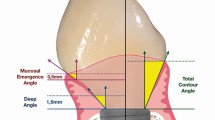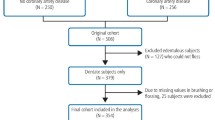Abstract
Data sources
PubMed (1966–April 2004) provided the primary data source along with the bibliographies from identified articles and reviews. A manual search of eight relevant journals (Clinical Implant Dentistry and Related Research, Clinical Oral Implants Research, International Journal of Oral & Maxillofacial Implants, International Journal of Periodontics and Restorative Dentistry, International Journal of Prosthodontics, Journal of Clinical Periodontology, Journal of Periodontology and Journal of Prosthetic Dentistry; published 2001–2004) provided a further source of data.
Study selection
Because no randomised controlled trials (RCT) were published in English language journals, it was necessary to include controlled clinical trials that compared tooth–implant reconstructions with solely implant-supported reconstructions. Prospective or retrospective cohort studies with a mean follow-up time of at least 5 years were also included.
Data extraction and synthesis
Assessment of the identified studies and data abstraction was performed independently by two reviewers. Failure and complication rates were analysed using random-effects Poisson regression models to obtain summary estimates of 5- and 10-year survival.
Results
Thirteen studies met the inclusion criteria. Meta-analysis indicated an estimated survival of implants in combined tooth–implant-supported fixed partial dentures (FPD) of, after 5 years, 90.1% [95% confidence interval (CI), 82.4–94.5], and of 82.1% (95% CI, 55.8–93.6) after 10 years. The survival rate of FPD was 94.1% (95% CI, 90.2–96.5) after 5 years and 77.8% (95% CI, 66.4–85.7) after 10 years of function. There was no significant difference in survival of tooth and implant abutments in combined tooth–implant FPD. After an observation period of 5 years, 3.2% (95% CI, 1.5–7.2) of the abutment teeth and 3.4% (95% CI, 2.2–5.3) of the functionally loaded implants were lost. After 10 years, the corresponding proportions were 10.6% (95% CI, 3.5–23.1) for the abutment teeth and 15.6% (95% CI, 6.5–29.5) for the implants. After a 5-year observation period, intrusion was detected in 5.2% (95% CI, 2.0–13.3) of the abutment teeth. Intrusion of abutment teeth were almost exclusively detected in nonrigid connections.
Conclusions
Survival rates of both implants and reconstructions in combined tooth–implant-supported FPD were lower than those reported for solely implant-supported FPD. Hence, planning of prosthetic rehabilitation may preferentially include solely implant-supported FPD. Anatomical aspects, patient-centred issues and risk assessments of the residual dentition, however, may still justify combined tooth–implant-supported reconstructions. It was evident from the present search that tooth–implant-supported FPD have not been studied to any great extent: more longitudinal studies examining them are urgently required.
Similar content being viewed by others
Commentary
This commendable systematic review complements three other excellent reviews1, 2, 3 focused on the survival rates of different prosthodontic interventions. This one deals with the survival of FPD that are supported jointly by implant and tooth abutments. The process for identifying studies and selecting studies, as well as the data extraction process, is described in adequate detail to replicate the work.
The review findings are intriguing in two areas, particularly. First, we are told that only 13 studies out of 560 titles met the criteria for inclusion set forth in the review. There is always a risk when undertaking a systematic review that the number of eligible papers becomes restricted if the criteria are too stringent or if the focus is limited to particular intervention outcomes. In this review, the inclusion and exclusion criteria seemed sensible in that all types of comparative prospective studies were included, and not only RCT. Moreover, the mean observation period was a minimum of 5 years and the outcomes were patient-centred and not mainly surrogate outcomes. Thus, the question arises, why have only a limited number of trials tried to establish whether this treatment modality is a viable approach to reduce the costs of implant-supported prostheses? In many circumstances, patients reject treatment plans for economic reasons, and even more so if presented with alternative options where additional implants can be placed with or without extractions and with or without an additional surgical grafting procedure. It is also important to clarify whether publication bias is an additional element to consider in this context.
The second point is the apparent general lack of quality assurance of the sourced studies and/ or publications. Of the 163 studies that were appraised in full text and subsequently excluded, it is remarkable that about one third of these lacked simple details such as adequate information about the superstructure or the implants. It is without doubt the responsibility of the chief editor of a professional journal to maintain the scientific standards of their journal — apparently this is not happening. The consequence of this situation is that it is more important than ever to train our current and future colleagues on critical appraisal skills.
References
Pjetursson BE, Tan K, Lang NP, Bragger U, Egger M, Zwahlen M . A systematic review of the survival and complication rates of fixed partial dentures (FPDs) after an observation period of at least 5 years. IV. Cantilever or extension FPDs. Clin Oral Implant Res 2004; 15:625–642.
Tan K, Pjetursson BE, Lang NP, Chan ES . A systematic review of the survival and complication rates of fixed partial dentures (FPDs) after an observation period of at least 5 years. III. Conventional FPDs. Clin Oral Implant Res 2004; 15:654–666.
Pjetursson BE, Tan K, Lang NP, Bragger U, Egger M, Zwahlen M . A systematic review of the survival and complication rates of fixed partial dentures (FPDs) after an observation period of at least 5 years. I. Implant-supported FPDs. Clin Oral Implant Res 2004; 15:667–676.
Author information
Authors and Affiliations
Additional information
Address for correspondence: Niklaus P Lang, Department of Periodontology and Fixed Prosthodontics, University of Berne, Freiburgstrasse 7, CH 3010 Berne, Switzerland. E-mail: nplang@dial.eunet.ch
Lang NP, Pjetursson BE, Tan K, Bragger U, Egger M, Zwahlen M. A systematic review of the survival and complication rates of fixed partial dentures (FPDs) after an observation period of at least 5 years. II. Combined tooth–implant-supported FPDs. Clin Oral Implant Res 2004; 15:643–653
Rights and permissions
About this article
Cite this article
Jokstad, A. Ninety-four per cent of combined tooth–implant fixed partial dentures survive 5 years. Evid Based Dent 6, 98 (2005). https://doi.org/10.1038/sj.ebd.6400366
Published:
Issue Date:
DOI: https://doi.org/10.1038/sj.ebd.6400366



